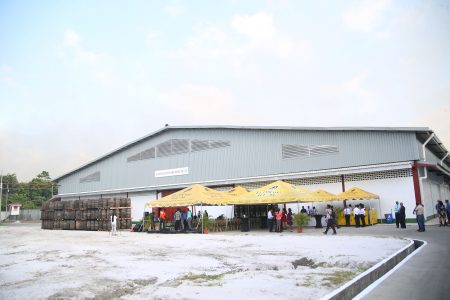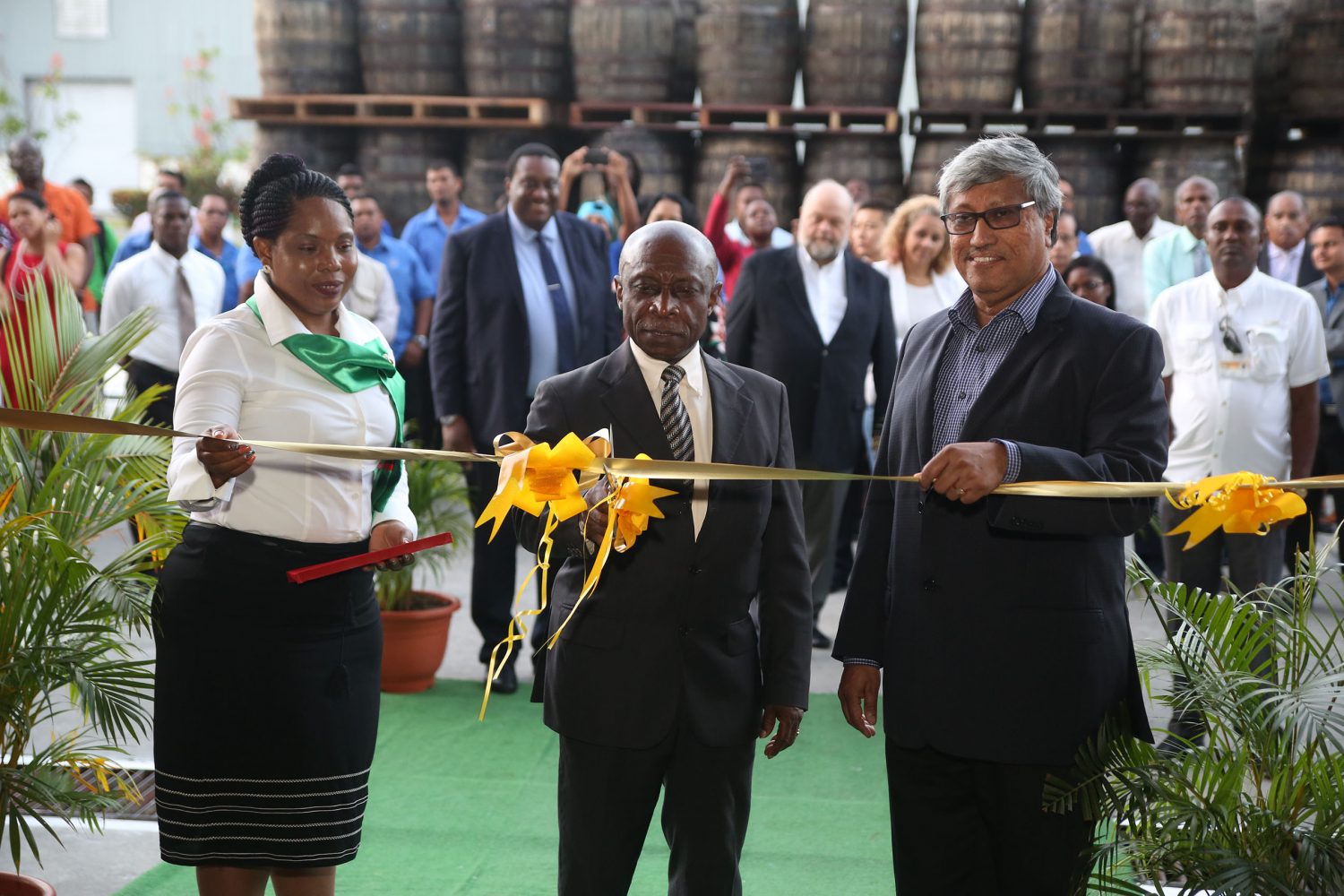Demerara Distillers Limited (DDL) yesterday launched a massive new rum ageing warehouse and also announced that an interim deal with GuySuCo will enable it access to molasses this year for its rum production.
This was conveyed by Chairman of DDL Komal Samaroo at a ceremony held to commission the warehouse at Diamond, East Bank Demerara. DDL’s access to molasses from GuySuCo had been in question after the sugar corporation announced sweeping plans to shutter four estates.
A component of an aggressive growth plan to increase its market share and presence as a leading supplier, the warehouse, designated ‘Warehouse M,’ along with specially designed roads signify a $340M investment by the company.

“One may ask why would we undertake such an investment because when you consider that the revenue that flows from this investment will not happen for another decade or two, it’s a very big risk but it is a risk worth taking because we believe in what we do, we believe in our product and I am pleased to say we were the pioneers of aged rum on the international market,” Samaroo said.
He further noted that though the company has set out on a journey to be a more significant player in the international premium spirits market, there are challenges that needed to be confronted. Among the challenges as stated by the Chairman is the downsizing of the local sugar industry, which he said represents an immediate and serious challenge.
However, he was pleased to note that with continuous work with the Special Purpose Unit of NICIL, GuySuCo and the government, they have managed to come up with short-term responses and long-term sustainable solutions.
“Indeed, I am very pleased to say that again today, we have come to a meeting of the minds on an agreement for the rest of 2018 to harvest the standing canes in the fields and convert it to inputs for the ground production so that we can continue producing throughout the year and by the time NICIL would have completed its process of evaluation, we would be in a position to negotiate and have a discussion on a more sustainable solution going forward,” Samaroo shared.
In addition, DDL also arrived at a separate agreement with GuySuCo to acquire additional lands to the east of its current location at Diamond to accommodate further expansion works; this agreement, he said, was only finalised yesterday afternoon. None of these agreements have been made public by NICIL or GuySuCo.
Regulatory review
Samaroo also moved to highlight the absence of subsidies, while also suggesting there be a review of the regulatory framework for the local rum industry.
“Let me make it clear that we operate in a very competitive environment, it is not easy going. Some producers in some countries enjoy subsidies, but we do not and therefore we have to be internationally competitive in what we do. The way forward has to be based on a competitive strategy so that we can carve our space in the global market,” the Chairman said.
“It is in this context that I believe there is urgent need to examine the regulatory framework in which our industry operates. The West Indian Rum and Spirit Association has recently undertaken an exercise to document the regulatory framework for the rum industry in Guyana and the rest of the Caribbean and to compare it to the framework that exists, such as the whisky industry abroad. We are preparing a document to present to the government where we think the regulatory framework of this industry needs to be brought in line with international best practice so that we can be in a position to compete with the giants of the world,” he underscored.
Meanwhile, Minister of Foreign Affairs Carl Greenidge, who is currently performing the duties of Prime Minister, responded to Samaroo’s call for a review of the local regulatory framework and referenced a body approved by CARICOM to work on addressing the challenges facing the rum industry.
“At the regional level, the regional rum producers are in the process of undertaking an exercise that has been approved by the CARICOM Heads at the most recent fifth meeting of the council that is to establish a working group that will be chaired by Guyana to deal with the challenges faced by the rum industry at the international level,” he said.
“We will try to ensure that the matters to which the chairman alluded, mainly subsidies and unfair trade in relation to the products that compete with rum are addressed,” Greenidge added.
Commenting on the commissioning of the new warehouse, the Minister commended DDL, which he described as a leader in the rum industry.
“Rum remains an important product notwithstanding all the changes that are taking place in terms of production; if we take gold and sugar out of the mix, you will find that rum is an easily identifiable leader among products in terms of Guyana’s exports and in that regard, the exercise undertaken by DDL is extremely commendable,” Greenidge said.
“DDL in the context of rum has been a leader in many respects and in relation to the industry that we knew, DDL through branding and other ways has allowed us to transition into modern times… I commend them for looking down the road and recognising that you have to move up the value chain to survive profitably… This company has a plan, it is following a path that will allow us to make a bigger mark for ourselves…,” he added.
100,000 barrels
Meanwhile, Shaun Caleb, DDL’s Senior Process Improvement Manager, in his overview of construction and technologies incorporated into the new warehouse, explained that Warehouse M has the capacity to accommodate 30,000 barrels, and forms part of the expansion plan to add storage capacity for 100,000 barrels.
Stabroek News understands that 30,000 barrels will be allocated for 2018 to 2020, 35,000 barrels for 2021 to 2024 with an additional 35,000 barrels for 2025 to 2027.
“This warehouse of capacity 30,000 barrels adds to an annual turnover of 90,000 barrels between those held in storage or that are processed among our four existing warehouse facilities and extensions. That represents a 1/3 increased in our carrying capacity and is strategically developed to support our goal of 15% of growth for the next decade,” Caleb said.
“More importantly, Warehouse M is not and end of itself, it is part of a process because the broader expansion plan aims for 100,000 barrels over the next decade so we are just only 1/3 of the way of Warehouse M,” he added.
In addition to the increased capacity, the warehouse was designed to minimise the energy footprint of their operations, as no electrical power will be used during the operation of the building
To go further, the roof of the building was constructed with galvanized sheeting with an ecofriendly ceiling made of double foil and double bubble insulation for temperature control.
According to Caleb, the entire project, which was approved by the Board of Directors in July, 2016, commenced with construction in January, 2017, with final construction of the building completed in February 2018.
The new warehouse utilises a piece of land which abuts the drainage canal aback the Diamond Bottling Plant and Diamond Warehouse K, which was previously left fallow because of poor soil condition and close proximity to the canal.
Caleb noted that it was through significant revetment and earth works to prepare the land for the foundation, that the building which measures 41,625 sq. feet, was constructed.




